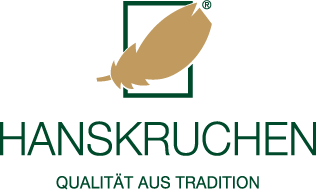Possible filling materials of a duvet and their differences
We spend a lot of time in our lives in bed, snuggled up in duvets. For a restful night’s sleep, you should therefore take a close look at the choice of the right blanket. Every person behaves differently during sleep, which is why you should work out the most important expectations of a blanket for yourself. Thus, the perfect blanket should be individually adapted to you. Today we will take a look at different filling materials for duvets and briefly describe their properties. Enjoy reading!

Down & feathers
We start with down and feathers, the most classic and well-known filling for duvets. We are specialised in down and feathers, which is why we only use this filling material for our products.
Down duvets are very light and cosy. For the same weight, they are considerably warmer and more moisture-regulating than synthetic products. One of the reasons for this is that down absorbs moisture up to 15 times better and forms air cushions with its little arms in which the warmth is stored. A duvet with this filling can contain goose down and/or duck down, whereby these must make up a proportion of at least 60%. Our down duvets have a down content of at least 90%, so they are extremely light but still cosy and warm.
Contrary to some rumours, down duvets are perfectly suitable for people with allergies. The down-proof and thus also mite-proof inlet means that mites don’t stand a chance. In addition, down bedding can be washed at 60°C.
Synthetic fabrics
The second category, synthetic fabrics, is divided into two filling materials: microfibre and Lyocell. Generally, duvets with a synthetic filling can be washed at high temperatures and thus also regularly cleaned of mites and bacteria. A big advantage of this filling is clearly the price. Duvets filled with synthetic fabrics are much cheaper than down duvets, although nowadays only high-quality synthetic duvets are able to imitate almost all the properties of down.
Microfibre
Duvets with a microfibre filling are very breathable and remove moisture in a similar way to sportswear. In direct comparison to down duvets, they have lower properties in terms of moisture permeability.
Lyocell
Lyocell is particularly breathable and soft. This material impresses with its very good moisture transport and is particularly suitable for people with a medium heat requirement.
Natural hair
Natural hair duvets are air-permeable and warm very well. In the following, we will mainly discuss four natural hair fillings — cotton, cashmere, silk and camel fluff.
Cotton
Cotton is very pleasant to the skin, but usually has a rather low warming effect. Cotton duvets have a high elasticity and are extremely easy to care for. With this filling material it is important to look out for the designation “kbA” (controlled organic cultivation), this ensures that the cotton has not been treated with toxic chemicals.
Cashmere
Cashmere is the finest and most valuable natural hair used for duvets. It is particularly suitable for people who need a lot of warmth, as this filling material is especially warming. Compared to a down duvet, the cashmere duvet is considerably heavier and not as puffy. However, the material is still particularly soft and pleasant to the skin. You cannot wash cashmere blankets at home; they have to be taken to the dry cleaners.
Silk
Silk has a cooling and temperature-balancing effect and is therefore ideal for people with a low heat requirement. This is why silk is mainly used for summer blankets.
Camel fluff
Blankets with a camel fluff filling are very high quality but unfortunately cannot be washed at home. You also have to take these blankets to the dry cleaner. On the one hand, the material is suitable for heavy sweaters, on the other hand, it is also suitable for people who need a lot of warmth at night. The camel fluff has very good warmth properties and besides that a good moisture regulation. Compared to a down duvet the material is considerably heavier and not as puffy.
There are many materials that are used to fill duvets. You have to find the perfect material for yourself, because sleep is individual. It is important that you neither sweat nor freeze at night, as this has a negative effect on your sleep. Before buying a duvet, think about whether you sweat at night, freeze, prefer a heavy or a light duvet and tell your bedding specialist.
BETWEEN TODAY AND TOMORROW
… A GOOD NIGHT!
Sources:
https://www.berlin.de/special/immobilien-und-wohnen/ratgeber/2780552–893025-bettdecken-daunen-wolle-und-synthetik-im.html
https://www.betten.de/magazin/schlafen-schlafkomfort-bettdecken.html
https://www.focus.de/gesundheit/news/daune-kunstfaser-baumwolle-welche-bettdecke-fuer-wen-geeignet-ist-und-fuer-wen-nicht_id_9493795.html
Contact
HANSKRUCHEN GmbH
Schuckertstrasse 3
48153 Münster
Germany
